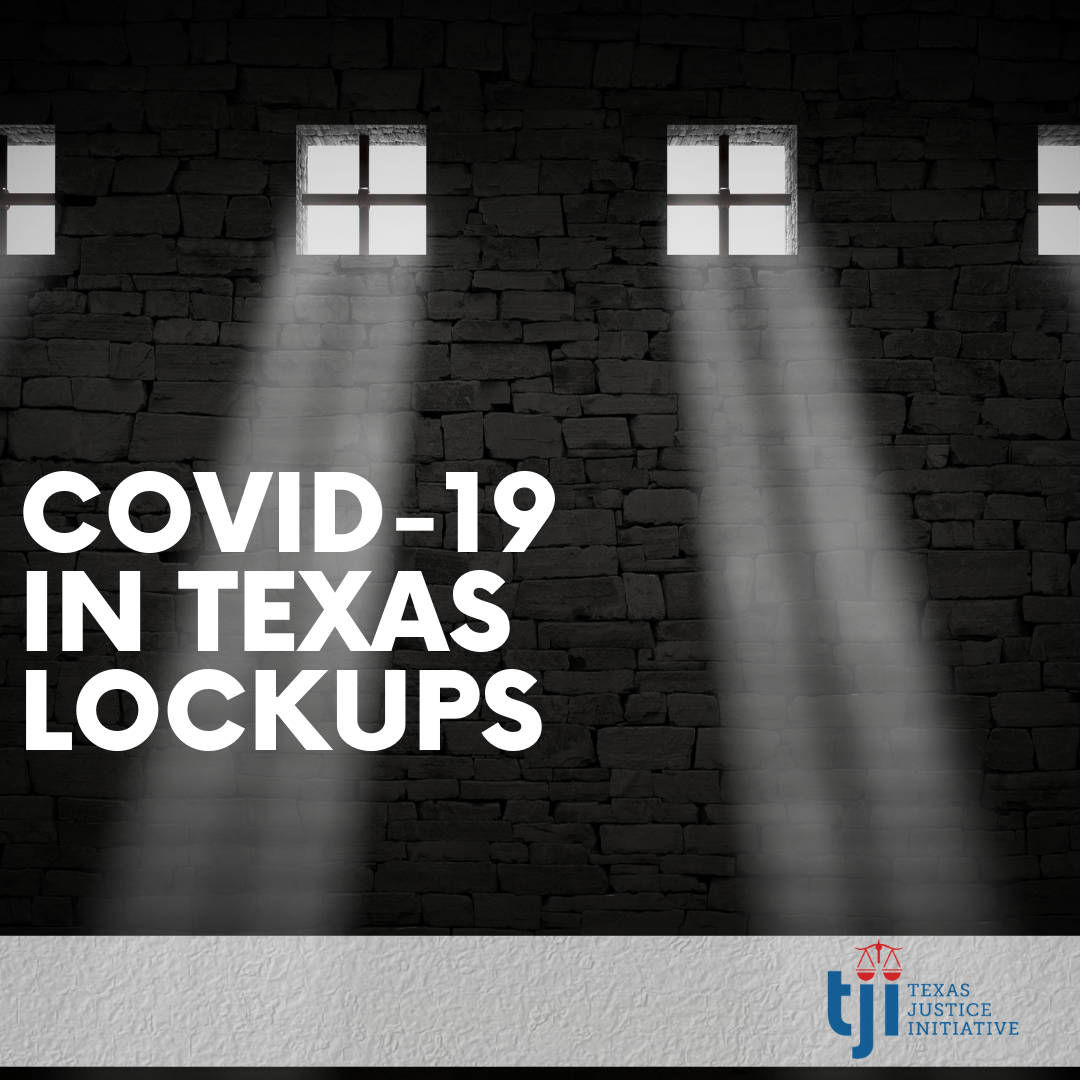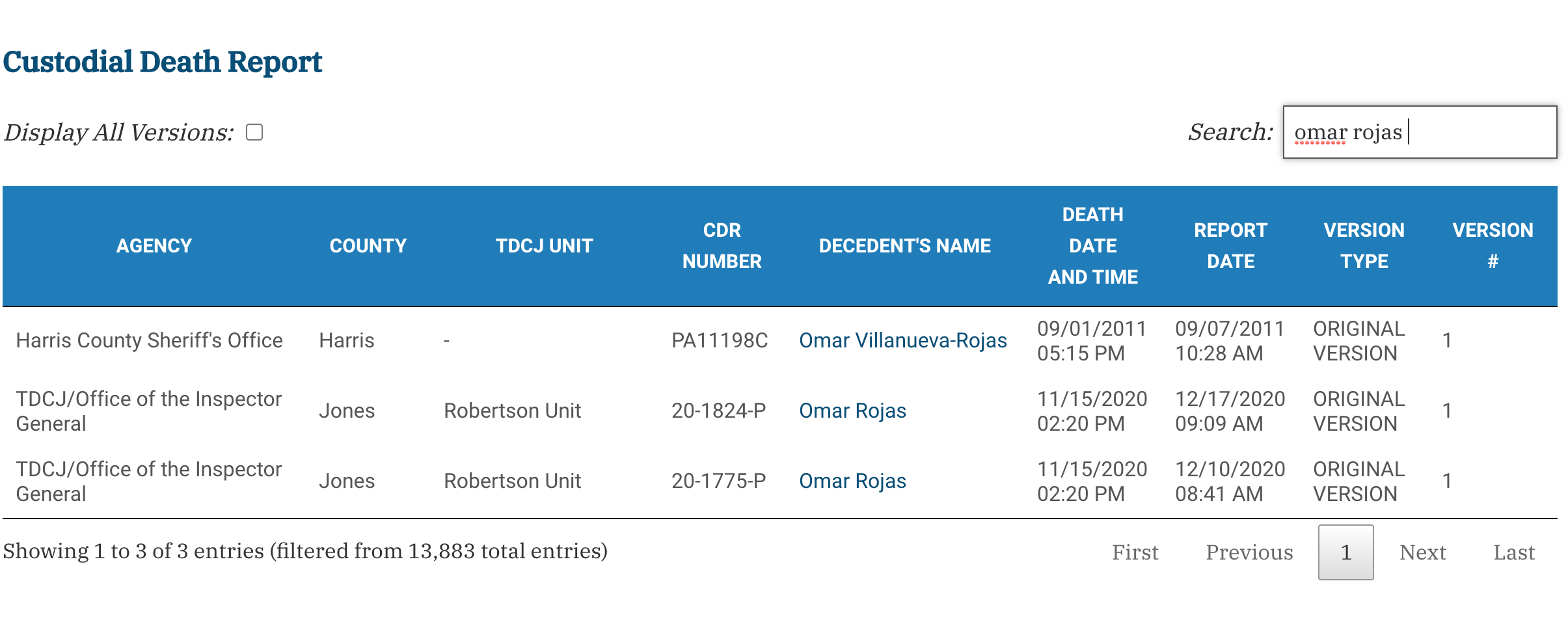Topic: data oversight
Posts related to data oversight
2021 Deaths in Custody decline from previous year
May 24, 2022The good news*: the number of people who died in the custody of Texas law enforcement went down in 2021 after peaking the previous year.
The bad news: 2021's total — 906 deaths, according to reports filed with the state of Texas through May 1, 2022 — was still higher than every other year but 2020.
Deaths in custody of law enforcement, including anything from a deadly shooting by a law enforcement officer or an overdose in the back of a patrol car to a death by suicide or medical cause in a prison cell, must be reported to the state of Texas within 30 days of occurring. Based on those reports, which TJI tracks every month, there were an average of 677 Texas deaths in custody from 2010 to 2019. Then, due undoubtedly in part to the 2019 coronavirus, deaths in custody rose nearly 45% higher than the prior 10-year average before dropping slightly in 2021.
The leading manner of death in 2021 continues to be of causes deemed “natural,” though the percentage of deaths by natural causes was fewer than in 2020 and for 2010 - 2019. The percentages of deaths due to “other” causes and “accidental” causes were slightly higher in 2021 than in 2020 and for 2010 - 2019, while deaths due to “homicide” were slightly lower. As in previous years, the highest concentration of custodial deaths in Texas took place among individuals over the age of 60.
* Good/bad news labels based on assumption that reducing the number of deaths that occur in the custody of Texas law enforcement is a positive thing
COVID-19 data scant during Delta variant wave
October 4, 2021For months, Texas has been battling the highly contagious Delta strain of the coronavirus. After a surge in the beginning of 2021, deaths due to COVID-19 were somewhat low in the spring – but then they started to climb.
And despite the rise in cases undoubtedly affecting individuals incarcerated in prisons and jails, who are particularly vulnerable to die from COVID-19, the actual reporting of infections and deaths in Texas lockups has mostly stopped.
For many months since the start of the pandemic, the Texas Commission on Jail Standards, which is responsible for ensuring county jails operate within state law, had asked jails to file daily reports on whether (and how many) infections were detected among staff and incarcerated individuals. However, that practice ended in June, when TCJS informed jails that the reports were no longer required.
Throughout the pandemic, the Texas Department of Criminal Justice, which oversees prisons, periodically announced deaths of employees and incarcerated individuals online. Yet no deaths of incarcerated individuals have been announced since mid-June.
Amid this dearth of data on COVID-19 deaths in Texas lockups, since mid-June, more than 13,400 Texans have died from the coronavirus, according to state data. Also since mid-June, the pandemic has killed at least 31 people who worked for county sheriff's offices and TDCJ, according to media sources, agencies and the Officer Down Memorial Page.
So just how many people have died of COVID-19 in Texas prisons and jails during this latest deadly wave? At least 18 – according to custodial death reports that agencies are required by state law to file within 30 days of a death. But the true number? It will take months to know for sure.

Texas Attorney General’s Sites for Death and Shooting Reports Go Dark
June 15, 2021For six weeks this spring, the Texas Office of the Attorney General’s websites that house reports on officer-involved shootings and deaths in custody were malfunctioning, cutting off access to records that detail important (and often lethal) interactions between civilians and law enforcement.
Every week, law enforcement agencies file dozens of reports with the Attorney General’s office that provide a glimpse into incidents like an officer’s use of deadly force, an incarcerated individual’s death, and shootings in which an officer is shot or shoots a civilian, resulting in an injury or a death. The office then posts these reports online – except that hasn't happened since severe winter weather hit the state and all updates ceased.
On Feb. 15, I noticed that both repositories were empty. After a couple of weeks, some reports appeared, and by the end of March, both collections appeared to be fully restored.
State laws require agencies to file these reports with the Texas Attorney General within 30 days of an incident in which an officer is shot or shoots someone, or when someone dies in their custody. The office then posts these reports online – a move stipulated by statute for the officer-involved shooting reports.
Said another way: By not publishing the reports on officer-involved shootings, the OAG was in violation of state law.
Back when the sites went down, I sent an email informing the office as such, as I have done in the past. On Feb. 22, I heard back:
Hi Ms. Moravec,
The OAG was closed all last week due to the weather and the electrical outages. I have reported the situation to IT this morning and they let me know they are working on it.
As soon as I hear back from them, I will let you know. Thank you for reporting this to us.
IT then followed up that “Salesforce recently rolled out another update,” which caused the outage. About a week later, many of the cases had been restored, but hundreds from this year and last year remain missing, which I again reported to the Attorney General’s office.
This outage means that when someone dies in law enforcement custody – such as Marvin Scott III, 26, who died in the Collin County Jail in March, the custodial death report that officials must file related to the death isn't visible online. That being said, reports (once they are filed) and data are still obtainable through open records requests. On March 22, we submitted an open records request to the Attorney General's office for the custodial death report for Marvin Scott III – not even knowing if it had indeed been filed. We received the report the next day and posted it publicly here.
While the sites were down, TJI continued to obtain data on these incidents from the Attorney General’s office through our standard monthly open records requests. During the outages, the data on our site was kept up-to-date to reflect all filed reports, although the actual reports were unavailable.
This lag in transparency took place during a tenuous time in Texas, with the novel coronavirus still a threat, particularly to those who are incarcerated, and amid winter storms that knocked out power for millions of Texans and claimed the lives of at least 57 people. It remains unclear exactly how the storm affected the health of those behind bars, but we promise to keep apprised of this situation and always share what we find.
This is How We Watchdog
December 21, 2020We frequently mention that we “watchdog” the data that we work with as much as possible, but I thought I’d peel that back a bit. What do TJI’s oversight efforts look like?
Each month, I get new data from the Texas Office of the Attorney General reflecting the previous month's reported deaths in custody and shootings of and by law enforcement officers. I add this new data to TJI's main data sets. Overnight, bots look for changes to the data sets, which are then pushed through our processing pipeline.
The data-entry process is still quite manual, and I often find errors in the submitted reports – everything from misspellings and wrong names to transposed dates of death that result in negative ages and narratives obviously pulled from a different report. I note these, as well as missing reports – reports on shootings that were the subject of media coverage but were not filed within the required 30-day time period. I recently went through this process and wanted to document and narrate what this effort looks like.
First observation: There were quite a few custodial deaths in November – 144 deaths reported in that month alone, when we usually see around 90. Next, I noted a few missing custodial death reports:
- 11/5 fatal shooting of Reginald Alexander Jr. in Dallas;
- 11/18 fatal shooting of Pedro Martinez Jr. on the Tyler Junior College campus;
- 10/3 fatal shooting of Jonathan Price by Wolfe City police; and
- 10/9 fatal shooting of Ariel Esau Lujan by Houston police.
Then, I noted that there were two reports filed by separate people at the Texas Department of Criminal Justice for the 11/15 death of Omar Rojas:

And finally, the officer-involved shooting report for Reginald Alexander Jr. had been submitted by Dallas police, though media reported that he was shot by officers from another agency.
For each of these inconsistencies, I emailed the person at the agency responsible for filing the report and pointed out what I'd found. A couple immediately responded. One had misunderstood the law and filed the missing report that day, and another one said:
Hello Ma'am The officers involved do not work for the Dallas Police Department.
They are employed by the Dallas County community College system. They were unclear on whether or not they were set up to input information into the database.
I did not see a way to include in the drop down menu.
I will add the custodial death report because I do not believe that (they) have done so.
(I replied and advised that he run that by the OAG to be sure).
My best hope is that the agencies amend/file the reports, but if they don't, my only recourse is to point out to the Office of the Attorney General that the reports are missing. Even then, the OAG doesn't really have to take any action – they are merely a repository for those reports. Not filing a custodial death report is a Class B misdemeanor, states a law passed in 1983, though the punishment has never been used.
My approach, although toothless, often works. In 2020, agencies submitted 21 custodial death reports after I pointed out that the report was missing. But agencies can simply ignore my emails if they so choose, and then all I can do is tattle. It's great that Texas requires the collection of these reports, but watchdogging it can be a challenge, especially when the law has no teeth.